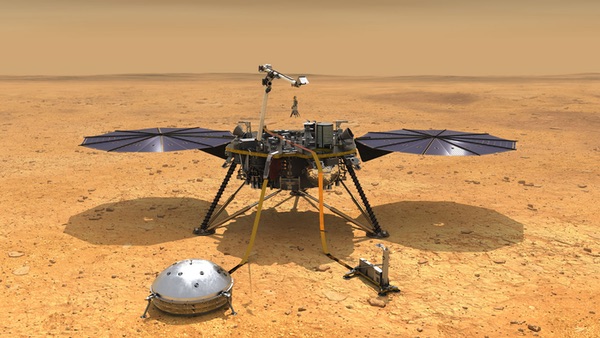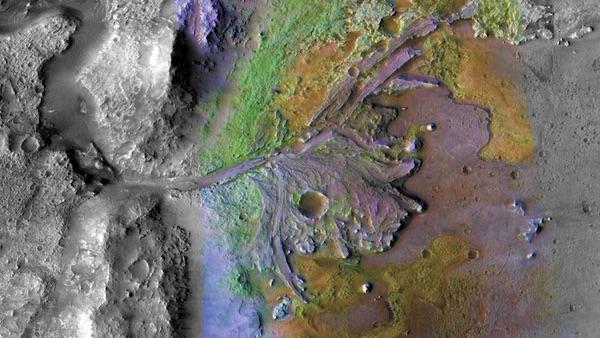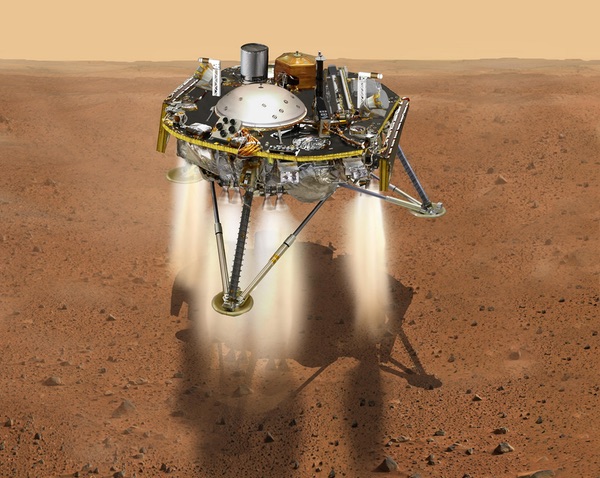A new InSight for Mars explorationby Jeff Foust
|
| “Going to Mars is really, really hard,” said Zurbuchen. |
Most of that velocity will be burned off—literally—by the spacecraft’s heat shield, with a peak deceleration of 7.5 g. Three and a half minutes after entry, the spacecraft, now about 11 kilometers above the surface and traveling at 385 meters per second, will deploy its parachute. Less than a half-minute later, it will jettison its heat shield and deploy its landing legs, while an onboard radar prepares to gather data on speed and altitude.
Forty-five seconds before landing, InSight will jettison the backshell that covered the top of the lander, and with it its parachute. Twelve descent engines will start firing on the lander, now descending at 60 meters per second and one kilometer above the landing site at Elysium Planitia. The thrusters further slow down the lander and rotate it into position, so that its twin solar arrays are aligned east-west.
At 2:54 pm EST, the lander, having slowed from 5,500 to less than 2.5 meters per second in the preceding six and a half minutes, will touch down on the Martian surface. If all goes well.
On Mars, of course, things don’t always go well. “Going to Mars is really, really hard,” said Thomas Zurbuchen, NASA associate administrator for science, at a briefing at the Jet Propulsion Laboratory November 21. “As humanity, explorers all over the world, we’re batting about 50 percent, or less, of successful missions.”
Mission officials, though, sounded confident about their chances. At that JPL briefing, officials said the spacecraft was working well, hewing to the planned trajectory so closely they had already skipped one trajectory correction maneuver (TCM) earlier in the mission and were considering foregoing a final TCM on November 25, the day before landing.
However, at a final briefing before the landing November 25, officials said they had decided to perform that final TCM in order to adjust the center of the landing ellipse by less than 20 kilometers, enough to keep the edges of the landing ellipse out of rougher terrain at Elysium Planitia.
“We listened to all the different inputs and the final decision was to go ahead and do the TCM and move ourselves back to that red X,” said Tom Hoffman, InSight project manager at JPL, referring to how the desired target was marked on maps of the region. That maneuver will ensure InSight is “exactly where we really want to land from both a safety standpoint as well as making sure we have the right location for our science instruments.”
| “We’re expecting a very plain day on Mars for the landing, and we’re very happy about that,” said Grover. |
The design of InSight is also Mars-tested. The spacecraft, built by Lockheed Martin, is based on the design used for the Phoenix mission that landed in the northern polar regions of Mars a decade ago. “The spacecraft itself is nearly identical,” said Rob Grover, EDL lead for InSight at JPL. The main difference in the landing, he said, is that Phoenix’s landing site was at an elevation about 1.5 kilometers lower, offering more time and atmosphere to slow it down.
InSight was also fitted with a thicker heat shield to prepare for any dust storms. Weather, though, won’t be an issue for the landing. While a massive dust storm spanned the planet in June, cutting off communications with the Opportunity rover that have yet to be restored, that storm has since faded. “For the last month or so things have looked really good,” Grover said. “We’re expecting a very plain day on Mars for the landing, and we’re very happy about that.”
If all goes well, controllers will get word of the landing within moments thanks to a pair of 6U cubesats, called Mars Cube One (MarCO) that launched with InSight in May. The cubesats will fly by Mars and serve as relays, rebroadcasting the lander’s telemetry back to Earth. (NASA’s Mars Reconnaissance Orbiter and Mars Odyssey spacecraft will also be able to return data, but with some delay, while InSight itself will broadcast an X-band “beep” seven minutes after landing.)
“As InSight goes through entry, descent, and landing, it will be sending up UHF data,” said Anne Marinan, MarCO-B mission manager. “The MarCO satellites will be listening to that data and relaying it back to Earth, almost in real time.”
The twin spacecraft, formally called MarCO-A and -B but dubbed Wall-E and Eve after the robotic lead characters in the animated film Wall-E, are primarily technology demonstration missions. The spacecraft have already tested a propulsion system that incorporates a propellant also used in fire extinguishers (hence the Wall-E connection), a deployable X-band antenna, and a small camera.
The flyby will mark the end of MarCO’s main mission, but project engineers suggested there may be opportunities for an extended mission for some time after the flyby, until the spacecraft, in their heliocentric orbits, are too far away to maintain communications.
Any future extended mission is not on their minds for now, however. “The team is focused on getting to EDL,” Marinan said.
“That’s the answer I asked to be given,” Zurbuchen added. “I’m a strong believer that focus is what creates success.” There has been consideration about what kind of extended mission might be possible, he said, but “we’re going to have these discussions at the back end of this exciting weekend.”
 InSight with its two main instruments, a seismometer (left) and heat flow probe, deployed on the surface. (credit: NASA/JPL-Caltech) |
Mars interior insights
InSight’s mission, though, will just be getting started. Sixteen minutes after landing—a gap intended to allow dust kicked up by the spacecraft’s thrusters to settle—the spacecraft will start unfurling its two circular solar arrays, a process that will take an additional 16 minutes. Confirmation of a successful deployment won’t come until five and a half hours after landing, when Odyssey passes over the site and is able to relay telemetry back to Earth.
InSight’s science mission will then begin, although slowly. “InSight is kind of a laid-back, slow-motion mission,” said Bruce Banerdt, the principal investigator for InSight at JPL. Engineers and scientists will first examine the region around the landing site, looking for the best location to place the spacecraft’s two major instruments, a seismometer and a heat flow probe. Then the lander’s robotic arm will deploy the seismometer, followed by the heat probe.
“It’s going to take us probably two to three months, at least, to get our instruments down,” Banerdt said, estimating it would be “early next spring” before those principal instruments started returning data.
The seismometer, formally known as the Seismic Experiment for Interior Structure (SEIS) and provided by the French space agency CNES, will measure seismic waves from quakes inside the planet, as well as from meteor impacts and even the tugging on the planet’s crust as the larger of its two moons, Phobos, passes overhead.
| “The number one question we want to answer is what’s the structure and the energetics of the interior of Mars,” Banerdt said. |
“At the beginning it was just impossible to build,” said Philippe Lognonné, project manager for the instrument at CNES. “But we did it with the help of our partners.”
The other major instrument is the Heat Flow and Physical Properties Probe, or HP3. It features a mole that will penetrate three to five meters into the surface, using a hammering mechanism that will perform as many as 20,000 strokes to reach that depth.
The instrument will collect temperature data from 15 sensors along the length of the probe. “By combining the temperature increase with the thermal conductivity, we can actually calculate the heat flow,” said Tilman Spohn, principal investigator for the probe at the German space agency DLR.
While SEIS and HP3 are the primary instruments on InSight, the spacecraft has other investigations. The Rotation and Interior Structure Experiment, or RISE, will use InSight’s X-band radio to detect perturbations in the planet’s rotation, which can help scientists understand the planet’s interior. A package called the Auxiliary Payload Sensor Subsystem includes a magnetometer and instruments to measure the Martian weather.
“This is going to be a unique data set of continuing measurements of temperature, barometric pressure, wind speed and direction, all day long, all night, over an entire Mars season,” said Banerdt. “That’s obviously going to, I think, have an enormous wealth of scientific information for us.”
Combined, scientists hope to learn about the Martian interior. “The number one question we want to answer is what’s the structure and the energetics of the interior of Mars,” Banerdt said. That includes the size and density of the planet’s core, the thickness of the planet’s crust and the structure of the mantle.
“I’ve personally have been waiting for this information for decades,” said Sue Smrekar, deputy principal investigator for InSight at JPL, “and I’m super excited to get this lander on the ground and start taking this data.”
 An image of Jezero Crater, the landing site for the Mars 2020 mission that features the remnants of a river delta that could preserve signs of life. (credit: NASA/JPL-Caltech/MSSS/JHU-APL) |
Back to the search for life
InSight is something of a detour on NASA’s Mars exploration strategy, which has focused on the study of past and present water there and its implications for the planet’s habitability. (InSight, in fact, is not formally part of the overarching Mars Exploration Program of directed science missions, but rather the Discovery program of competitively selected, low cost Mars missions.) InSight is studying the planet’s interior, and on formation processes of Mars in comparison to other terrestrial planets, rather than the “follow the water” mantra that guided NASA’s Mars missions for nearly two decades.
| “The delta is a good place for evidence of life to be deposited and preserved for the billions of years that have elapsed since this lake was present,” said Farley. |
The next mission, though, will return to that focus. The Mars 2020 rover, slated for launch in July 2020 for a February 18, 2021, landing, will resume studies of the past habitability of Mars. More importantly, it will collect samples for later return to Earth for more advanced study.
And now NASA knows where Mars 2020 will land. The agency announced November 19 that the rover will land in a 45-kilometer-wide crater called Jezero. That crater, scientists said, hosted a lake 3.5 to 3.9 billion years ago that was as deep as 250 meters. Images of the crater also show the remnants of a delta from a river that flowed into the crater around that time.
The sedimentary deposits left behind by the lake and the delta is what attracted scientists. “This is a major attraction from our point of view,” said Ken Farley, Mars 2020 project scientist, at a briefing to announce the site. “The delta is a good place for evidence of life to be deposited and preserved for the billions of years that have elapsed since this lake was present.”
The selection of Jezero was the culmination of a process lasting several years. “It was well over a four-year process,” said Michael Meyer, lead scientist for the NASA Mars Exploration Program, “At the first landing site workshop in 2014, there were 64 sites identified as potential places to go.”
By the time scientists met in October for the fourth and final workshop to assess landing sites, they had narrowed that down to four. Besides Jezero, there was a nearby region called Northeast Syrtis that appeared to have ancient rocks of interest. Midway got its name from its location between Jezero and Northeast Syrtis, allowing scientists to both sample ancient rocks like those at Northeast Syrtis while being in driving range of Jezero. A fourth site, the Columbia Hills region visited by the Spirit rover, fell out of contention at that workshop, with scientists split among the other three.
Just as InSight is based on the earlier Phoenix lander, Mars 2020 makes use of the same design of the Curiosity rover currently exploring Gale Crater, including its “skycrane” landing system. One addition to Mars 2020 will be the use of a new technology called terrain relative navigation, where the spacecraft will take images during its descent, compare them to maps on the spacecraft itself, and use that information to navigate to a more precise landing.
That will enable Mars 2020 to avoid obstacles in Jezero that range from fields of boulders and sand traps to the cliffs at the edge of the delta. “Scientists always want to see outcrops, which are boulders and cliffs, and the people who are responsible for landing the rover safely are trying very hard to avoid those things,” Farley said.
Zurbuchen said that a final decision about using terrain relative navigation on Mars 2020 will be made next fall, he said, after “additional and extensive analysis” of what he called an “exciting technology.”
Mars 2020 will be equipped with dozens of specially designed metal tubes that will store rock and soil samples for later return to Earth. However, when, and how, those samples will be returned have yet to be determined.
| “I’m going to control myself as well as I can until we get a first notification of a successful landing,” Hoffman said. After that, “I’m going to unleash my inner four-year-old.” |
More than a year ago, NASA unveiled what it called a “lean” architecture for sample return. Under that approach, Mars 2020 will be followed by two missions. One will land in the same area as Mars 2020, with a rover designed to gather up the sample tubes and place them into a carrier, which the new lander will then launch into Mars orbit. The second follow-up mission will collect that sample canister in Mars orbit and return it to the Earth, either directly or to some intermediate location, like the International Space Station or the new lunar Gateway.
Neither of those follow-on missions have been fleshed out: Mars 2020 remains the only Mars mission on NASA’s books after InSight. NASA signed an agreement with the European Space Agency earlier this year to study potential cooperation on sample return, but the specifics of any cooperation have yet to be fleshed out.
“We’re going to give a lot more clarity about what that means exactly in the next budget cycle,” Zurbuchen said in June. “The first time we’re really going to start tying up things, really making decisions because we have parallel joint investigations going on in Europe as well, is late ’19. It’s not a decision this week or next week or next month.”
That’s still the case five months later. “I don’t have any updates today” on the status of sample return planning, Zurbuchen said at the announcement of the Mars 2020 landing site.
He did say that NASA was planning on launching the later elements of that sample return architecture in the late 2020s. “Depending on how the details come out, it would be in the early ’30s that the samples would come back to Earth,” he said.
For now, the excitement, and tension, is focused on InSight. At the final pre-landing briefing November 25, Hoffman noted that he had family visiting for Thanksgiving, including three young grandsons. “When they get excited, they run around like crazy men, raising their hands, yelling and screaming, carrying on. I have to tell you, inside of me right now I’m just about that same way,” he said.
He’s holding it in, for now. “I’m going to control myself as well as I can until we get a first notification of a successful landing,” he said. After that, “I’m going to unleash my inner four-year-old.”
Note: we are temporarily moderating all comments subcommitted to deal with a surge in spam.
